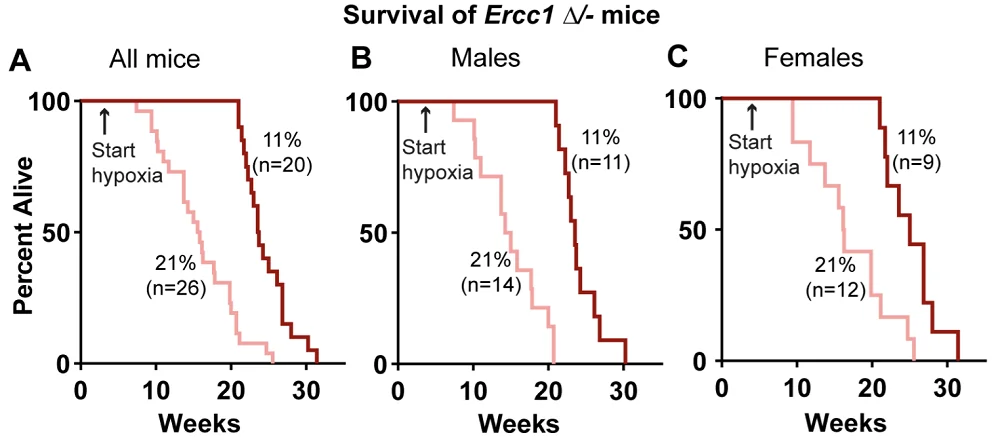Scientists have found that continuous oxygen restriction drastically extends the lifespan of progeroid mice, but the effect’s mechanism remains a mystery [1].
Can less oxygen be better?
Hypoxia is a condition in which an organism or an organ in the body does not receive enough oxygen. However, how much is enough, and whether we are breathing an optimal amount of oxygen, depends on context. Acute hypoxia can result in tissue and organ damage and, obviously, death. On the other hand, research suggests that long-term mild hypoxia might actually be beneficial.
There is some epidemiological evidence that living in a high-altitude environment [2] or even moving to one in adulthood [3] positively affects healthspan and, potentially, lifespan. Some athletes train in such environments to increase their cardiovascular fitness. Mammalian cells grown under chronic continuous hypoxia conditions enter replicative senescence later [4]. Continuous hypoxia also extends lifespan in simpler animal models, such as yeast, nematode worms, and fruit flies [5].
Although little is known about the effects of chronic, continuous hypoxia on mammalian lifespan, many burrowing mammalian species are long-lived. This includes the famous naked mole rat, which enjoys its enviable longevity while living in a highly hypoxic environment.
Drastic lifespan boost
In this new study, scientists tested chronic continuous hypoxia in a mouse model of aging. Those genetically modified mice (Ercc1 Δ/- mice) experience early aging, despite not having any physical disabilities at birth. While Ercc1 Δ/- mice are popular with geroscientists (no need to wait for a couple of years for mice to age naturally), they do not fully recapitulate natural aging.
At four weeks of age, slightly before the first sign of premature aging appears in Ercc1 Δ/- mice, the study group was transferred to a chamber in which oxygen concentration was cut in half, from the normal 21% to 11%.
The median lifespan of these progeroid mice was extended by continuous hypoxia by a full 50%, which is on par with the best-known interventions in this model. The increase in maximum lifespan was less drastic, but still noticeable, which shows “compression of mortality”: a bigger effect on healthspan than on maximum lifespan. Hypoxic mice were also much stronger.

Since one of the most potent anti-aging interventions in mice is dietary restriction, the researchers investigated whether hypoxia made mice eat less. However, this was not the case: oxygen-restricted mice actually ate more than the control group under normal conditions. The average body weight, though, remained similar in both groups. Progeroid mice undergoing caloric restriction, despite being healthier and living longer, end up being smaller than their freely fed counterparts. Hypoxia did not seem to impose such a trade-off.
No explanation for now
However, when researchers attempted to elucidate the mechanism behind this powerful effect, they hit a wall. The Ercc1 Δ/- phenotype is characterized by impaired DNA repair, but the researchers did not detect considerable differences in the DNA damage marker γH2Ax between progeroid mice under hypoxia or a normal oxygen concentration (normoxia).
Progeroid mice also accumulate more cellular senescence, but two popular senescence markers, p21 and p16, did not significantly differ between the two groups.
While Ercc1 Δ/- mice experience faster decline in health across multiple organs, they are thought to die mostly from neurological disorders related to loss of neurons. However, RNA sequencing data from the cerebellum did not deliver any insights, with only one gene (Armcx5) and no gene ontology pathways differentially expressed in hypoxia versus normoxia.
Using their transcriptomic data, the researchers then attempted to analyze the scope of DNA damage via an indirect marker based on gene length (if genetic damage is stochastic, longer genes get damaged more often, so their expression should be lower when DNA damage levels are higher). However, this marker was also mostly similar between the two groups. The researchers concluded:
Overall, despite the fact that Ercc1 Δ/- mice maintained in hypoxia are significantly more robust at approximately 4 months of age than those maintained in normoxia, we did not observe this difference reflected in the cerebellar transcriptome nor in classic markers of DNA damage and senescence in peripheral tissues.
This study had numerous limitations, beginning with the choice of the model. Progeroid mice are good for quick proof-of-concept studies, but further investigation into this intriguing effect of hypoxia requires working with normally aging mice. As the researchers point out, analyzing additional biomarkers, including other markers of DNA damage, might shed more light on the subject. They also call for additional studies that would investigate a combination of hypoxia and caloric restriction to see if there’s any cumulative effect.
Literature
[1] Rogers RS, Wang H, Durham TJ, Stefely JA, Owiti NA, et al. (2023) Hypoxia extends lifespan and neurological function in a mouse model of aging. PLOS Biology 21(5).
[2] Zubieta-Calleja, G. R., & Zubieta-DeUrioste, N. A. (2017). Extended longevity at high altitude: Benefits of exposure to chronic hypoxia. BLDE University Journal of Health Sciences, 2(2), 80.
[3] Singh, I., Chohan, I. S., Lal, M., Khanna, P. K., Srivastava, M. C., Nanda, R. B., … & Malhotra, M. S. (1977). Effects of high altitude stay on the incidence of common diseases in man. International journal of biometeorology, 21, 93-122.
[4] Leontieva, O. V., Natarajan, V., Demidenko, Z. N., Burdelya, L. G., Gudkov, A. V., & Blagosklonny, M. V. (2012). Hypoxia suppresses conversion from proliferative arrest to cellular senescence. Proceedings of the National Academy of Sciences, 109(33), 13314-13318.
[5] Rascón, B., & Harrison, J. F. (2010). Lifespan and oxidative stress show a non-linear response to atmospheric oxygen in Drosophila. Journal of Experimental Biology, 213(20), 3441-3448.



